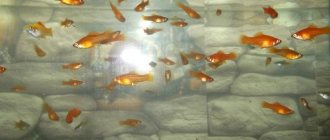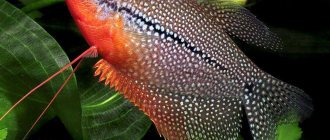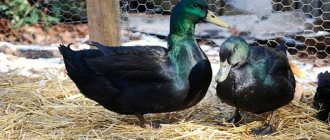These fish easily interbreed with each other, so over the years, breeders have bred many species in almost every color of the rainbow. The most popular species are Red, Tiger, Lemon and Clown. It is noteworthy that the natural variety (Green Swordtail), which became the ancestor of almost all other breeds, has now practically disappeared from aquariums.
Appearance and structure
Swordtails with a red color and a caudal fin with one elongated ray painted black can be called the “classic” and most recognizable aquarium variation. In an aquarium, fish grow up to 8-10 cm.
In nature, swordtails have a rather modest color - their body is brownish-greenish or yellowish. However, as a result of many years of breeding work, it was possible to develop many varieties of them, distinguished by a variety of colors. The fish can be red, black, yellow, spotted, etc.). The bred forms also differ in fins - in addition to the standard form, there are also veil ones. There are also forms with two rays on the caudal fin.
Female swordtails are larger than males. Males have a gonopodium, a copulatory organ through which fertilization of the female occurs. Males have a silver stripe running along their body, and the sword sometimes has a black edge.
An interesting fact is that under certain conditions, females can change sex to the opposite.
Average prices in pet stores in Moscow
Swordtails can be purchased in pet stores in a variety of colors and fin shapes. The most popular remains the red swordtail. This is a classic of the aquarium genre. For such a fish, sellers of branded pet stores ask from 50 to 100 rubles. This is the price of a swordtail that has already grown up.
In simpler trade enterprises or from private individuals, the price of swordtails starts at 10 rubles. It is possible to receive swordtails as a gift. These fish reproduce quickly and fill the aquarium spaces. A caring owner periodically faces the task of transferring excessively proliferating swordtails to other hands.
Habitat
The homeland of swordtails is Central America. They are found in bodies of water in countries such as Mexico, Honduras and Guatemala.
It is noteworthy that their endurance and ability to adapt allows them to live in a wide variety of biotopes: in slowly flowing small rivers, in mountain rivers with strong currents, and even in wetlands and stagnant lakes. Moreover, today they have spread in nature and beyond their natural range. Swordtails are found in the waters of India, Africa, the USA and even the UK.
The species has become invasive in some regions, threatening natural biodiversity. And the reason for this is the person himself. Aquarists provoked this situation by releasing swordtails into natural conditions in their countries.
Sex differences
The fish belong to the Petsiliev family. Their body is elongated, somewhat compressed at the sides. Due to the fact that they feed mainly from the water surface, they have an upturned mouth.
The sex of newborn swordtails is difficult to determine. They do not have pronounced sexual characteristics. They begin to appear 3 to 6 months after birth.
The differences between female and male swordtails are visible to the naked eye.
It is not difficult to distinguish males and females in adulthood. The male has a long outgrowth; it is compared to a sword located on the tail. The fish owe their name to him. The fact that the male specimen has a pointed and narrow anal fin also helps determine the sex.
Females are paler compared to males. Their anal fins are wide and rounded. In males they are elongated, tube-shaped. They carry out fertilization with them, right in the belly of females.
In length, the fish reach sizes of 8–10 cm. At the same time, males are smaller than females, on average by 2 cm (adults).
Swordtails are fish that can change their gender during their lives. There are about 500 such species in nature. This metamorphosis is possible due to the lack of chromosomes that are responsible for belonging to a particular sex.
However, the main factor in the transformation is the threat of extinction of the local group. Swordtails, changing, are trying to save the population.
If the male dies, after a certain period of time, any female may turn into a male fish. But the offspring produced using the replacement female will produce only females.
Conditions of detention
Swordtails belong to the so-called “harem” fish. It is optimal to keep 2-3 females per 1 male in one aquarium. If you decide to keep several males, then you need to arrange shelters in the aquarium where weaker males can hide from the attacks of their relatives. Under optimal conditions, life expectancy reaches up to 5 years.
Aquarium
For a group of swordtails of 3-4 individuals, of which one is a male and the rest are females, you will need an aquarium of 50 liters or more. Fish are characterized by mobility and jumping ability, so it is necessary to provide the aquarium with a lid.
About water
It is recommended to take care of high-quality water filtration and good oxygen saturation. The optimal temperature for keeping swordtails is 20-28°C, water hardness is in the range of 9-19° dGH and pH = 7.0-8.0, but these fish do not really like frequent water changes in the aquarium, 25-30% of the aquarium volume It is recommended to replace it once every one to two weeks. You need to take into account the majority of the population of the aquarium, because for most tropical fish, replacing once a week is usually the norm, but swordtails do not like this.
Some aquarists periodically, both for medicinal purposes and for prevention, add a little salt to the water - a concentration of up to 1 g/l. Provided that there are no other fish species living with the swordtails that could be harmed by salt.
What is the best soil to choose?
The choice is not important - any will do. But swordtails will look more impressive against the background of dark soil.
Vegetation and scenery
Since in nature these fish thrive in dense thickets, similar conditions for their comfort should be created in the aquarium. Use plants: cryptocoryne, vallisneria, echinodorus, etc., the more magnificent, the better.
But thickets should be alternated with space for free swimming. It is also recommended to place natural driftwood at the bottom; they will become an excellent place for the growth of microalgae, the fouling of which swordtails love to feast on.
Other decorations in the form of pots, grottoes, castles, etc., which the fish will use for relaxation, are also welcome.
Equipment
The aquarium should be equipped according to the standard, as for most other types of fish, these are filters (external or internal, depending on the volume of the aquarium), an aerator, a thermostat, a thermometer.
Lighting
Swordtails are not demanding of lighting; diffused lighting is best. It all depends on the population of the aquarium, if there are a lot of plants in it, then the range and intensity should be appropriate.
What diseases are swordtails susceptible to?
One of the important advantages of these fish species is their resistance to various diseases. When buying a new fish, you should place it in quarantine (leave it in a separate jar for this time), and only then release it into the aquarium. This action will make it clear whether the fish is sick or healthy.
The main cause of diseases is improper care. Poor living conditions and lack of live and plant food in the diet reduce the fish’s immunity. Weakened individuals are prone to contracting ichthyophthyriosis (aquarists call this disease semolina ). The causative agent is an equiciliated ciliate, which begins to actively multiply on the body of weak fish, causing itching. A white coating also appears on the surface of the scales and fins. Don't worry, because the fungus is quickly and easily treated. It is enough to immerse the infected fish in salt water or a weak solution of manganese. Beginners should only use salt, since the wrong dosage of manganese can kill the fish.
The main problem for swordtails is chylodonellosis . Most other fish species do not suffer from this disease. The main symptoms by which the disease can be identified:
- A blue-gray coating appears on and around the dorsal fin;
- Appetite worsens;
- The fish becomes lethargic and inactive.
Sick fish should be immediately quarantined and treated with antiprotozoal agents.
We recommend reading the article: Aquarium fish diseases, symptoms, treatment
Common types of aquarium swordtails
Aquarium swordtails can be divided into two groups: natural and obtained through selection.
Despite the fact that the natural species of these fish cannot boast of bright original colors, some aquarists take great pleasure in populating their aquariums with them. Among the popular natural forms are swordtails:
Alvarez (Xiphophorus alvarezi)
The most expensive and rare type. The habitat of the blue swordtail (the second name of the fish) is the fast-flowing rivers of Mexico and Guatemala. In the natural environment, life expectancy is approximately two years, the size of an adult reaches 6-7.5 cm. Females are slightly larger in size than males.
The key feature of this species is the longitudinal stripes on the body of red and blue shades (two or three), formed from points merging with each other. The basic color of the fish's body may vary. In this category there are representatives with a red or green ball, spotted color. This species has a rather peaceful disposition. It is best to keep a small group of fish in an aquarium consisting of two males and three females.
Clemencia (Xiphophorus clemenciae)
Habitat: waters of the Sarabia River, Mexico. The adult size is approximately 4–5 cm. The body is mainly colored silver-blue. A distinctive feature of this breed is a characteristic red-orange stripe along the body, as well as a black stripe along the bottom of the abdomen, turning into the caudal fin and outlining the sword.
Representatives of this species are unpretentious, have a peaceful disposition, and get along well with other fish (guppies, gourami, zebrafish). Males can be distinguished by their xiphoid process in yellow or lemon tones. Clemensias are not often seen in aquariums because... This species is difficult to reproduce. In addition, the female gives birth to small offspring.
Pygmy (Xiphophorus pygmaeus)
The small fish barely reaches 5 cm, which is why it is often called the dwarf swordtail. It lives in fast-flowing rivers of Central America, as well as northeastern Mexico. Life expectancy under favorable conditions is 3–6 years. The peculiarity of this species is that females and males are approximately the same size. And sexual dimorphism is expressed in differences in body color. The bright yellow males, which have a brown stripe along the entire body, as well as a small xiphoid process on the caudal fin, are easily distinguishable from the females, which are colored an unremarkable gray shade.
It is important to know that the species has a cocky character, so you need to choose their neighbors very carefully. It is not recommended to keep them with other breeds/species of swordtails.
Montezuma (Xiphophorus montezumae)
The fish species was first discovered in Mexico. Due to their rather high price (the cost per pair can reach $100), they are not often seen in home aquariums. The size of the fish is 4–8 cm. They look very bright and impressive. For their lush dorsal fin of bright color, representatives of this species received the name royal swordtail . The base color of the body can vary from bright yellow to lilac-silver or brown. The body is lilac-silver and may have black spots.
The “sword” of the fish is quite long, its size is approximately the same as the main body. The bottom of the sword is decorated with a black stripe. The fish has a shy disposition, so it is very important to provide numerous hiding spots in the aquarium. It is best to keep one male and a couple of females.
Round-headed swordtail (Xiphophorus birchmanni)
This type of fish looks significantly different from its other relatives. Moreover, it literally does not justify the name “swordtail,” since the males of this species do not have a xiphoid process on the caudal fin. The name “round-headed” was due to its high forehead. What sets these fish apart from other aquarium inhabitants is their gorgeous fan-shaped dorsal fin. This fin is present in both males and females. In females, the entire body and fin are silver-gray in color. In males, the fin is colored lemon yellow. It contains numerous inclusions of black, which makes it even more impressive and beautiful. The fish have a fairly high body, and the entire body is marked with vertical stripes.
The round-headed swordtail has a peaceful and calm disposition. It gets along well in community aquariums. This is a schooling fish and should be kept in groups. But to avoid fights and aggressive behavior between males, it is necessary to provide swordtails with a large space with a predominance of females.
Fish of this species were actively used in breeding work. The result of crossing with poeciliid fish was the appearance of more than 20 new decorative aquarium varieties. They are distinguished by a brighter and more original appearance, significantly different from the color characteristic of natural forms.
Pregnancy and childbirth
Several signs help determine pregnancy. So, first of all, the stomach testifies to this. In a pregnant woman it is round and large. The transition from the front part of the body to the abdomen is pronounced (step-like). As a result, the fish's head looks small and graceful, unlike other, non-pregnant fish.
Near the anal fin of the female, a dark-colored spot begins to be visible, indicating that the fry are gestating. It darkens over time and increases in proportion to the stages of development of the offspring. Before childbirth, the abdomen takes on a rectangular shape, and a protrusion forms near the cloaca.
A pregnant female swordtail acquires an impressive size before giving birth!
Swordtails bear their offspring in a common aquarium. Pregnancy in females lasts from 4 to 6 weeks. Depends on a number of conditions:
- parameters of the aquatic environment, temperature;
- the degree of illumination of the aquarium, or the duration of daylight hours;
- food ration, its quality;
- age and health status.
Before giving birth, the fish's behavior changes. She rushes around the aquarium and becomes restless. She loses her appetite. If there is vegetation, the expectant mother tries to hide in it. If there are no plants, it stays near the bottom, hiding behind the decorations. Or it hides in the corner of the aquarium, in places where neighbors cannot disturb it.
If these signs are established, then the pregnant fish should be immediately transplanted into the spawning tank. This must be done so that the fry that are born do not become food for other inhabitants of the aquarium.
Some breeders use the fibers of a synthetic washcloth for the spawning tank, in which the fry will hide from their hungry mother.
Usually the spawning tank is a small aquarium, from 10 to 20 liters. After birth, the fry will be raised in it. Before transplanting the female into this tank, it should be filled with water from the previous habitat of the woman in labor. This is necessary to eliminate the stressful state of the pregnant female. It is recommended to place floating vegetation in the spawning tank. Subsequently, the newly born fry will hide in it.
Genera of swordtails
Practice shows that in viviparous female swordtails, spawning occurs in the morning; this process lasts from several hours to a day. In this case, 50 - 200 babies may appear. The fish give birth to one fry after approximately equal periods of time. Once born, swordtails tend to the surface and seek shelter in plants, or sink to the bottom.
After the end of the birth, the female should be resettled back into the general aquarium. This must be done so that she does not destroy or eat her offspring.
The most popular breeds of aquarium swordtails
Green or common swordtail
This breed was the first to be bred artificially. It is also the most common due to the attractive appearance of the fish and ease of maintenance.
A dark blue stripe runs through the entire body, and the back may have a green, bluish or bluish color. Males have a xiphoid process, which is framed along the top and bottom with black stripes. The average size of the fish is 10-15 cm, with the length of the xiphoid process being at least 1/2 the length of the body.
Red swordtail
It is distinguished by a rich scarlet color that covers the entire body, including the fins and xiphoid process. This color was achieved as a result of repeated crossings with the red platy.
Red swordtails are easy to care for, which has made them very popular among aquarists. Today, breeders have managed to develop a large number of varieties of this breed, differing in the shape of their fins and “swords”.
Black swordtail
Bred by crossing the green swordtail and black platies. The body has a basic black color, sometimes with minor green or yellow inclusions. The fins are uncolored, and the xiphoid process can be yellow, green, white or black. There are also colorless, like fins, processes. Very sensitive to oxygen and nitrate content in water.
Lemon swordtail
An albino variety of green swordtail. The entire body, fins and “sword” are yellowish in color. In rare cases, the xiphoid process may have a black border.
Calico Swordtail
The result of crossing tiger and red swordtails. The color turned out to be very original and unusual. But breeders have still not been able to completely stabilize the result. Only a small percentage of fry receive the desired tricolor coloration from their parents. The body of this breed of fish has a basic silver-white color with numerous black and red markings and inclusions.
Bulgarian white swordtail
Another variation of the albino swordtail. The main part of the body is transparent, but the front part, eyes and head are scarlet. The breed is characterized by endurance and good survival rate. The fish have a peaceful nature, which makes them comfortable neighbors in shared aquariums.
Black and White (Hell's Swordbearer)
It has a very impressive appearance, thanks to the combination of blue and red tints on a white body, which change depending on the lighting. But individuals with black and white coloring, as stated in the name of the breed, are quite rare. The length of the xiphoid process in males can vary greatly - from 5 mm to the length of the entire body.
Cuban swordtail
The main body color is red, with large black spots scattered on the lower and back parts of the body. It is interesting that the history of the breeding of this breed and what types of fish were used for selection are not known for certain. Moreover, the breed is called “Cuban” only in Russian terminology; specialists in Western countries call this breed red-black swordtails .
Rainbow Swordtail
The breed was bred from white Bulgarian swordtails. The main color of the fish's body is silver-white-green, and several longitudinal stripes of red-orange color run along the body. The fins are terracotta in color. The fish are peaceful, take root well in community aquariums, and grow up to 8-10 cm in length.
Pineapple swordtail
The breed was bred from the common green swordtail and has a spectacular carrot-red body color. The coloring is especially rich on the caudal fin, back and dorsal fin. The xiphoid process has a black border. The fish grow up to 8-10 cm.
Mountain swordtail
The main color of the fish's body is orange-yellow or cream-colored. In different lighting it shimmers with purple and pink shades. The fish is distinguished by a very lush fan-shaped dorsal fin, which, like the whole body, is decorated with numerous inclusions of black color. The process in males is pink or whitish in color with a black edge.
Red-mottled tiger swordtails
The body of the fish is painted in a terracotta-carrot color, and the dorsal and ventral fins have a rich scarlet color. Spotted tiger spots are scattered throughout the body, their concentration increases in the tail part.
Varieties of fish
- Green swordtail - distinguished by its olive color with a greenish tint. Along the horizontal side of his body there is a bright red stripe and several lighter stripes. The body is laterally flattened, and the sword on the tail of males is beautifully edged. Females are slightly larger and have lighter shades.
- Lemon is an albino variety of the previous species. Its only difference lies in the yellowish tint of the body. They do not survive reproduction well.
- White Bulgarian swordtails are also an albino variety, but they are more viable than lemon ones.
- Black ones are a hybrid from crossing green swordtails and black pelicia. Their body is somewhat wider compared to the usual species. Color – black with a greenish or bluish tint. Fish often suffer from a disease associated with an excess of pigments in the body. This makes it difficult for them to reproduce.
- Red - were obtained by crossing green swordtails and red pelicia. The species is distinguished by its bright red body color.
- Calico Swordtail - they are named so due to their tricolor color - the main white color of the body is supplemented by several large black and reddish spots.
- Rainbow - similar in color to Australian rainbow fish. Their body is gray-green with an orange tint. There are red-brown stripes along it. The fish's fins are bright orange.
- Tiger swordtail - they got their name because of the pronounced black spots on a red background. Males have a long sword on their tail.
- Mountain - their body is creamy yellow, and on the sides there are small spots and barely noticeable zigzags.
- Cortez's swordtails (Xiphophorus cortez) - the birthplace of this species in nature is the country of Mexico. The size of individuals is from 5 to 5.5 cm, females are also larger than males. There is a brown zigzag stripe on the body from the tail to the eye. The scales of the fish are gray-yellow, and there are specks on the fin of the back. The sword on the tail of males grows up to 2 cm in length and is yellow in color.
- Microswordtail (Xiphophorus xiphidium) – this species also lives naturally in the climate zone of Mexico. The female swordtail reaches 5 cm, and the male does not grow more than 4 cm. This species is beige or olive in color with or without vertical stripes. There are dark spots on the tail. The sword on the tail of males is transparent and short, only 5 mm.
- Clementia swordtails (Xiphophorus clemenciae) – individuals reach 4.5 – 5 cm in length, but the female is much larger than the male. The body is silver-blue with reddish horizontal stripes. The sword on the tail of the male is large - up to 3.5 cm in length.
- Montezuma's swordtail (Xiphophorus montezumae) - the body length of the female of this species reaches 7 cm, and the male - a maximum of 5 cm. The body is painted in a lilac shade, which turns into brown on the back. There are also several zigzag stripes on the body that are paler than the main color. The male is distinguished by a yellow dorsal fin with dark speckles.
- Swordfish KoiKohaku, also known as Santa Claus - this species is distinguished by three large spots of bright red color on the white body of the fish. Santa Clauses can reach 10 cm in length.
- The forked swordtail (forked) - got its name due to the unusually forked shape of the tail.
- The Cuban swordtail is a bright red variety with black fins.
- The Berlin swordtail is a large individual, growing up to 10 -12 cm in length, excluding the tail in males. The lower fin resembles a pike, and the lower part of the abdomen is darkened.
- Pineapple swordtail (Xiphophorus hellerii var.) - has bright orange fins and the same color on the lower half of the body.
- Flag swordtail - so called because of its dorsal fin, it is large and resembles a sail in appearance. The subspecies is considered to be the ruby flag swordtail, which has a rich red color. Also a subspecies of the flag species is the red blacktail.
- Lyretail swordtail (Xiphophorus helleri) is a breeding form of green swordtail with an unusually shaped caudal fin.
From the editor: Marbled gourami
Varieties of swordtails by fin shape
By crossing different breeds of swordtails with each other and with other species of fish, new varieties continue to appear, differing not only in color, but also in the shape of their fins. Today, experts identify several main forms of fins in aquarium swordtails.
Flag - the dorsal fin is large with an elongated shape, reminiscent of a flag. The gene that is responsible for this fin shape is dominant, which makes it easier to breed fish with a flag fin.
Lyrebird - the tail has a very beautiful shape with elongated upper and lower arrows. This shape resembles a musical instrument, hence its name. Similar arrows are also present on the ventral and dorsal fins.
Forked - has a similar shape to the lyretail, but there are 3 or 4 arrows on the caudal fin. This makes it similar to the cutlery of a fork.
Veiled - the fish are decorated with lush long fins that look like a veil. They are distinguished by importance, slowness and some nobility in behavior.
Sail - the fin looks like a flag shape, but is even longer and more spectacular.
We have given examples of only some of the breeding forms of swordtails; there are several dozen of them. Many of them are peaceful in nature and easy to keep, which makes the fish popular among aquarists. They will undoubtedly become a decoration for any aquarium.
red swordtail
other varieties of swordtail by fins
Which breed is best to choose for your aquarium and why?
Almost all breeds of Swordtails are well suited even for inexperienced aquarists, since they have a spectacular appearance, are very unpretentious to the conditions of detention and reproduce easily. However, it is important to remember that complex breeds and hybrids have reduced immunity, are more prone to certain diseases and live shorter lives even with good care .
That is why it is recommended to choose the most stable species: Green (regular), Red (Ruby) and Tiger Swordtails. In the future, if you wish and have some experience, you can purchase other breeds with bizarre colors or unusual fin shapes.
Feeding
Fish are unpretentious in food, so any food will do (dry - flakes, granules, sticks, etc.), frozen and live food (brine shrimp, tubifex, aulophorus, daphnia, coretra, bloodworms, etc.). These aquarium inhabitants most often eat food near the surface, but can take food in all layers of water.
The best option is a balanced diet of plant and animal feed. Surprisingly, swordtails tolerate fasting well for 1-2 weeks, without harm to their health, provided that there is enough dense vegetation in the aquarium. The fish will eat the plants and algae that form on the walls of the aquarium.
Diseases: prevention and treatment
Every aquarist should carefully monitor the behavior of their pets and their external condition. Most diseases that have not reached a severe stage can be cured, so it is important to identify them as early as possible. Infected fish are immediately transplanted into a quarantine tank.
It is important! Fungal diseases of swordtails are treated with fungicides, bacterial diseases with antiseptic drugs. Fish also tolerate salt baths well.
Injuries
Sword bearers can be injured during fights with rivals or injured on the edges of decorations and equipment. To avoid inflammation and infection through wounds, add hydrogen peroxide (2.5 - 5 ml per 10 l) or streptocide to the aquarium according to the instructions.
Chlorine poisoning
Being active fish, swordtails consume a lot of oxygen. Active breathing can lead to the accumulation of chlorine in the body and, as a result, to intoxication.
Signs of poisoning:
- lethargy;
- yellowness of the gills and mucus on them;
- the fish are trying to jump out.
Letting the water settle before changing or starting the aquarium, as well as using air conditioners, will help you avoid unpleasant consequences. You can control the level of the substance using a chlorometer: ideal indicators for swordtails would be 0.03 - 0.05 milligrams of chlorine per liter.
Poisoned fish are transplanted into a clean tank until the water in the main aquarium is renewed.
Ichthyophthiriasis, or semolina
Sudden changes in temperature or too cold water can lead to the appearance of semolina. Then the swordtails begin to itch on any surface, and a whitish coating, similar to semolina, appears on their scales.
The causative agent of the disease is the ciliate. This is a completely natural inhabitant of aquariums, but the swordtail with weak immunity becomes a breeding ground for this simple organism.
The first step to recovery is to gradually increase the water temperature to the upper limit of normal and relieve the fish of stress. If this measure does not help, you should start treatment with a solution of malachite green. Swordtails tolerate this drug without problems.
Chilodenellosis
The most common disease among swordtails. It is caused by a parasitic ciliate, Chilodonella. The first symptoms of infection are low activity, freezing of the individual, and refusal to feed. The swordtail's fins droop, and a gray coating appears on the back.
Antiprotozoal drugs will help get rid of chylodenalosis. Sick swordtails are moved to a quarantine tank.
Mycobacteriosis
One of the most dangerous diseases for aquarium swordtail fish. It is not easy to identify, since the first signs are similar to the symptoms of other diseases: the pet becomes passive, loses appetite, and gets lost in space. At a later stage, black spots and ulcers appear on the body.
Before the onset of complete fading and the appearance of serious abscesses of the swordtail, you can try to treat it with copper sulfate, trypoflaive or minocycline. At advanced stages, the fish die.
Fin rot
The infection can affect both adult swordtails with weak immunity and fry. Externally, the disease manifests itself in the gradual destruction of the fins. Until the infection penetrates the body and affects its nervous system, the fish is treated in containers with a weak solution of methylene blue (the color of the water should be pale turquoise) or salt (1 tablespoon per 10 liters). If these drugs do not help, you need to use chloramphenicol (1 tablet per 20 liters).
Compatibility
Swordtails are quite peaceful and get along without problems in common aquariums. But the male can become a local “bully”. Most often this is caused by incorrect selection of the sex and age composition of the inhabitants of the aquarium. The best option is to keep one male swordtail with several females. If there are several males, then the number of females should significantly predominate in order to disperse the attention and aggression of the males. It is also necessary to ensure that the aquarium is large enough so that the swordtails do not bump into each other at every step.
Almost all peace-loving fish can become neighbors of swordtails. The proximity to platies and mollies will be favorable; peaceful cichlids (for example, angelfish), tetras, minors, zebrafish and barbs, and popular species of catfish (corydoras, ancistrus, thoracatum) will also be suitable.
An unfavorable neighborhood is with large, aggressive cichlids: acara, astronotus, cichlids, and proximity to fish with lush, veiled tails (fins), for example, with cockerels, goldfish, since swordtails are quite capable of biting them.
Compatibility of the listed aquarium fish with each other
When the aquarium is properly populated, Swordtails behave quite peacefully: the main thing is that the number of females exceeds the number of males, otherwise endless attacks and chases will begin. Different breeds, as a rule, also get along well together and can even interbreed, producing unexpectedly colorful offspring.
The aquarist needs to take into account the characteristics of each variety. It is better not to house small and large Swordtails together, as small fish will inevitably act as prey.
In addition, some species (for example, the Black Swordtail) cannot tolerate an overcrowded aquarium, so it is better to keep them separately or choose completely different fish as neighbors. For more information about this issue, read the interesting article about the compatibility of Swordtails with other fish: Guppies, Gouramis, Mollies.
Breeding and reproduction of swordtails
Since swordtails are viviparous fish, they do not spawn. The eggs mature in the abdomen of the female. The process of the appearance of fry is called ovoviviparity and the main task of the aquarist is to preserve the offspring, since fish lack parental instinct.
Maturity in swordtails occurs at 5-7 months. Sexual characteristics of fish are clearly expressed. Males are smaller in size, they have an elongated ray of the caudal fin - “sword”, and for fertilization of females there is a modified anal fin - gonopodium. It is along the gonopodium, like a gutter, that the male’s reproductive products enter the female’s reproductive tract, to make it easier for the male to stay near her; there is a small hook at the end of the gonopodium.
Preparation, spawning, conditions
Special conditions for fertilization and spawning are not required; the whole process can take place perfectly in a general aquarium. During fertilization, you can observe how the male performs a kind of “mating dance” around the female, moving back and forth.
The maturation of eggs in the abdomen of the female lasts about 30 - 40 days, depending to a large extent on the water temperature (the higher, the faster it ripens) and feeding. And if you plan to keep the offspring, then it is recommended to place the female ready for spawning in a separate container.
Water for the aquarium can be taken from a common aquarium. The spawning aquarium should contain a large number of small-leaved, lush plants that will serve as shelter for the fry.
A female ready for spawning exhibits the following signs: the abdomen becomes larger and takes on a square shape. A characteristic “birth” spot appears, dark in color at the anus.
pregnant female livebearer
not pregnant female livebearer
Pregnant and ready to spawn female swordtail
The number of fry is from 15 to 100, depending on the age and size of the female.
Interestingly, the ambient temperature affects whether there will be more males or females among the fry. At lower temperatures, more females are born, and at higher temperatures, more males are born.
At the end of spawning, it is better to immediately return the female to the general aquarium, otherwise she will begin to eat her offspring. The fact is that in nature, when the fry appear, they immediately move away from the female with the current, she does not see them. But in an aquarium, fry can be perceived as food.
An interesting fact is the ability, under certain circumstances, of female swordtails to turn into a male. At the same time, she also acquires the external characteristics of a male in the form of a sword tail, gonopodium, etc. This usually happens when there are no males. The offspring from a female and a “former” female consists mainly of females (about 90%).
Pairing
For a pair of swordtails, 6 or more liters of water are recommended. During the mating process, 2 - 3 females are involved for the male.
Mating of swordtails
Those who have decided to start breeding swordtails with the aim of raising offspring should know that the important conditions for this are the appropriate temperature regime, a separate maternity aquarium or a hatchery. As well as maximum isolation of young fish from adult fish, for which they are ordinary food. In a community aquarium, they are likely to become hunted by other inhabitants.
Only strong and bright sires will be able to produce strong offspring.
To breed swordtails, you need to pay attention to the selection of producers. Strong, viable fry are obtained from individuals that are completely healthy.
Therefore, sick and weak fish should not be considered as parents.
Male swordtails can reproduce from 5 to 6 months, but it is better to choose those who have exceeded 8 months of age. For females, the best age is from 10 months. They should have a rounded abdomen. This indicates the fish is ready to reproduce.
Before mating swordtails, the water must be changed regularly, on average once a week. At least 25% of the aquarium volume must be replaced. Maintain water temperatures higher than usual, from 28°C to 30°C. But it must be increased gradually over the course of a week.
The number of offspring the female will bear depends on the quality of the water. Clean water, saturated with oxygen, encourages swordtails to courtship and mating games. Filtration must also be present. The aquarium should be covered with a lid, due to the fact that during their active movements and games, swordtails jump high.
A responsible owner should check the quality of the water.
When breeding this type of fish, it is possible to plan the number of males and females in the offspring. When the water temperature is less than 24 degrees, more females are born. If it is 25 or higher, then more males will be produced. The main parameters for keeping fish before breeding are the acidity of the water, from 7 to 8 pH, with a hardness of 10 to 11. Ammonia and nitrate levels must be maintained at the lowest possible level. The frequency of birth of fry depends directly on the living conditions of the parents.
A female, after one mating, without the help of an individual of the opposite sex, is capable of producing offspring several times. Because she stores male milk remaining after sexual intercourse, and on her own, after a certain time, she can fertilize herself.
Pygmy swordtail (Xiphophorus pygmaeus)
Pygmy swordtail
There are several more poorly studied species of swordtails. And all other swords are artificially bred breeds. Some of them are imitation of Montezuma and Alvarez swordtails, obtained artificially. Let's say the Berlin swordtail is a hybrid of Heller's swordtail and the red black-finned artificial breed of spotted platie Xiphophorus maculatus.
History of the discovery of the species
The first description of fish with a xiphoid process on the tail appeared in 1848. It was made by the Austrian biologist Karl Bartholomew Heller during an expedition to Mexico, organized to study the local flora and fauna. Then the green swordtails were recognized as a biological species and named after the discoverer - Xiphophorus hellerii.
They began to be kept as aquarium fish in 1864. The first pets were green swordtails. And a little later they were joined by Alvarez swordtails, Montezumas, Clemencias and pygmies, brought to Europe from Central America.
Interesting! The scientific name of the species has Greek roots and consists of two words – xiphos (“sword”) and phoros (“to carry”).
Description and features
Swordtails reach small sizes in natural and aquarium conditions. The length of males, depending on the variety, varies between 4-10 cm. Females are larger in size - up to 12 cm. Fish are naturally mobile, this is facilitated by developed fins and a streamlined body shape.
Swordtails are built very proportionally. The head makes up 15-20% of the total length. Caudal fin - about 20%, excluding the sword in males. In some species, this decoration can reach 50% of the body length. A species called the Montezuma swordtail can boast such an impressive “weapon.”
Females of almost all species are 12-17% larger than males. Their rounded fins cannot compare with the variety of shapes and sizes of the males' motor organs. In addition, the male's caudal fin has grown into a gonopodium, a reproductive organ that delivers male gomets to the female's body.
The color of females is dim, the shades depend on the habitat, pale gray, brown, and greenish tones prevail. In many natural species, females have spots in their overall color. Males compensated for the color modesty of females. Some species dress in outfits where one color predominates, such as the green swordtail. Some are painted quite variegated.
The diversity of natural species, unpretentiousness, simple maintenance of the swordtail , and a reliable reproduction system have brought swordtails to household aquariums. This happened at the beginning of the last century. Breeders and breeders immediately paid attention to them. As a result, the number of fish belonging to the genus Swordtails and living in home aquariums is several times higher than the number of Swordtails living in natural bodies of water.
What to feed Swordtails
To feed Swordtails, you need to combine plant and live food purchased at a pet store. Live or frozen food: bloodworms, tubifex, coretra mosquitoes or crustaceans of daphnia and cyclops.
Before feeding, frozen food must be thawed to room temperature.
If there is enough decorative vegetation in the aquarium, Swordtails can survive for a long time without additional frequent plant feeding, feeding on various algae that grow on plants.
Despite the ability of Swordtails to survive for up to 2 weeks without any feeding at all, to maintain good health the fish must still be provided with regular combined nutrition.
The ideal food for newly hatched Swordtail fry is a variety of live ciliates, microscopic rotifers, as well as traditional cyclops and daphnia, which can be purchased as fresh, clean aquarium plankton. Either turn live or frozen food into minced meat so that the food fits into the fry's mouth.
Health and life expectancy
Under favorable conditions, swordtails live in captivity for 3-4 years. Bright aquarium fish have good immunity and get sick mainly due to violations of living conditions. They are susceptible to diseases such as:
- chlorine poisoning;
- fin rot;
- mycobacteriosis;
- chylodenosis;
- ichthyophthyriosis.
Swordtails are cute aquarium fish with pronounced sexual dimorphism and a peaceful disposition. They are undemanding to their living conditions and will delight those who take the time to provide them with minimal comfort for a long time.
Care
The fish do not require special housing conditions, so swordtails are most often acquired by beginning aquarists. Fish live on average 4-5 years.
Requirements for water and aquarium
Swordtails are quite large fish, they need a lot of free space. It is believed that for a comfortable stay one individual needs at least 35 liters of water. For a medium-sized flock you need a tank of at least 100 liters.
The water in the aquarium should be settled, with an almost neutral reaction and average values. Fish will feel good at water temperatures from 18 to 28°C, but the optimal level is 23-25°C.
Once every 7-14 days you need to replace a quarter of the water in the aquarium with fresh water. The water needs to be filtered and saturated with oxygen.
[direct]
Nutrition
The fish are unpretentious in food; they will happily eat live, freeze-dried, frozen and dry food - flakes, chips, bloodworms, daphnia, granules, etc.- Feed is captured at any water level, even at the bottom or on the very surface.
- Swordtails do not feel full and may overeat. You should not add food “in reserve” so as not to kill the fish.
- The diet must include plant foods such as spirulina or algae tablets. The fish will happily eat the algae that forms on the plants and walls of the aquarium. It is important that the diet is balanced and varied, that dry and live food alternate.
If the aquarium is densely planted with live plants, swordtails can comfortably do without feeding for 7-14 days - pieces of plants and small snails will be enough for them.
Conditions of detention
In the wild, swordtails live in bodies of water filled with vegetation. Comfortable conditions in an artificial reservoir can be created with the help of cryptocorynes, duckweed, Vallisneria, Riccia and similar plants.
The aquarium must be covered with a breathable lid - the fish are very mobile, they can get scared or chase other fish and accidentally jump out.
Shelters are not necessary, but if there are many males in the group, you can put several snags in which weaker individuals can hide from aggression.
When it comes to aquarium soil, swordtails are unpretentious. A dark one will look best - the fish look quite contrasting on it.
[ads]











